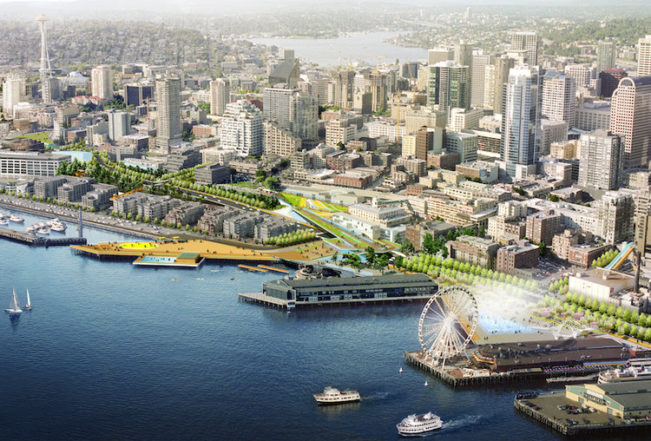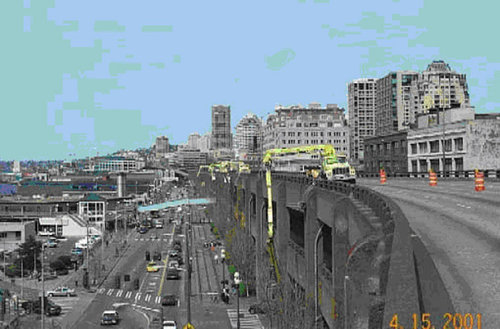
“American cities are built on their waterfronts,” said Carol Ross Barney, founder and design principal at Ross Barney Architects.
“The irony is because they were built on waterfronts and the water was used for transportation, most of [the fronts] are abandoned now because the industries that depended on that transportation are no longer there.”
In 2001, the City of Chicago commissioned Barney’s firm to help transform the riverfront. At the time, people couldn’t fathom the idea of bringing Chicago to the river. It was a project “architects and planners had dreamed about, but everyone else was like, ‘Really? You’re going to go down to the river?’” Barney explained.
That feeling that urban waterways are polluted eyesores resonates across America. But as communities begin pushing for cleaner local waters and prime urban space, people start turning their attention back to the abandoned waterfronts.

Just 80 miles north of Chicago, three decades ago, Milwaukee residents wanted nothing to do with their city’s river. “It was kind of the city’s back door — nobody paid attention to it,” said Alyssa Remington, project manager for the City of Milwaukee’s Department of City Development. “It was contaminated, it smelled, it wasn’t anything [anyone] wanted.”
In 1984, people started realizing something needed to change. Not only did the Milwaukee River need cleaning up, but the city also saw it as a missed economic opportunity. In 1994, construction on the riverwalk began.
Seattle experienced the same realization, but it took a natural disaster to turn people’s attention back to the waterfront.
On February 28, 2001, a 6.8-magnitude earthquake shook the western Washington city, structurally damaging the seawall that held downtown Seattle up from the water and the viaducts that separated the city from the waterfront.

“Because of that damage there was all this interest, concern, and state and federal money that went into the waterfront project,” said Andrew tenBrink, associate architect at James Corner Field Operations. “A citizen group said, ‘If you’re going to rebuild the seawall and come up with a solution to handle the structural damage on the viaduct, there should be a new public realm associated with that.’”
That’s where JCFO came in.
After selected to lead the design for the Seattle Waterfront Project in 2010, JCFO approached the project at different scales. One of those scales — looking at the bay. “The big idea around that was reconnecting Seattle back with Elliot Bay,” tenBrink said.
“American cities are built on their waterfronts.”
“Historically, the waterfront was industrially focused,” he continued. Because of that, “the city sort of turned its back on the bay. The idea of re-centering Seattle on the bay and making it the front porch instead of the backyard [became] a core concept.”
Fast-forward to 2016.
Since taking on the Seattle Waterfront Project just six years ago, tenBrink’s already noticed an increase in development around the water’s edge. “It’s in large part to people looking forward to the new park and promenade that’ll be there in the [coming] years,” he said.
And even though the seawall project is in active construction, crowds of people can be seen going to the shoreline. “We were down there on a nice Tuesday afternoon a couple of months ago and it was just packed!” tenBrink exclaimed.

What was once seen as a “missed opportunity”, the Milwaukee Riverwalk is now a booming investment. “It’s been a huge economic generator,” said Remington. Looking at just the area adjacent to the river and one street back, the city has “seen almost a billion dollars worth of property value increases since 1994.”
Going beyond the economic value of the reinvented riverfront, it’s also changed the way people experience Milwaukee. “People were not drawn to the river previously. Now, [people] come to Milwaukee, and, instead of going down Water Street to a restaurant, you can walk down the riverwalk. It just adds something for tourists and residents,” Remington explained.
In Chicago, “people didn’t even know they needed a riverwalk, and now it’s one of the most popular places in town,” said Barney.
From the Pacific to the Atlantic, public and private communities have turned the spotlight back on their city’s waters. New York’s currently implementing Vision2020, a 10-year plan released in 2011 describing waterfront improvements the state has for their 520 miles of shoreline. Los Angeles has been renovating their waterfront for over a decade, with more projects in the pipeline.
While people may have once turned their back on urban waterways, it would seem the tides are changing.
Explore some key areas along Seattle’s future waterfront!

Discussion
Be the first to leave a comment.
You must be a member of the BuiltWorlds community to join the discussion.